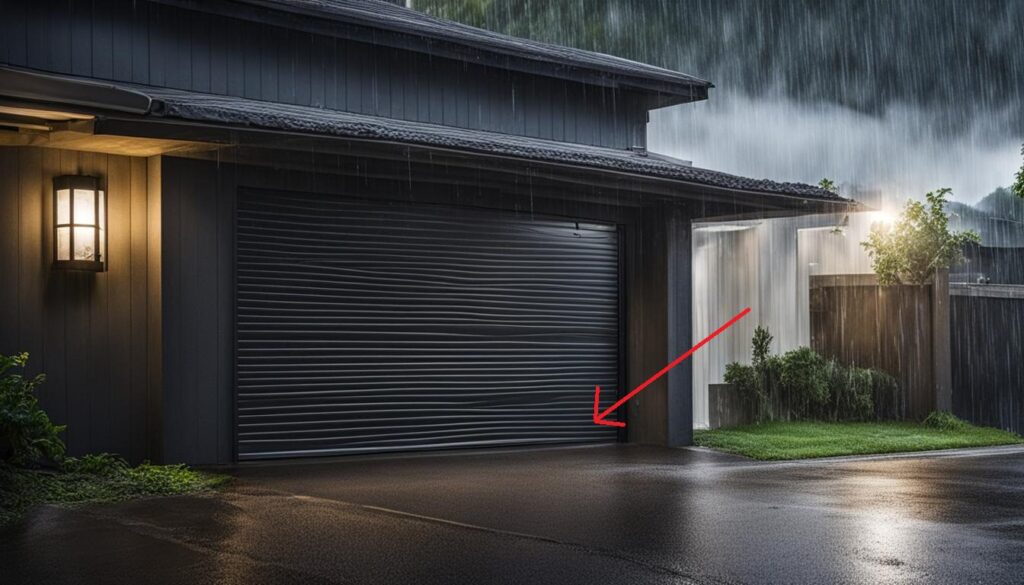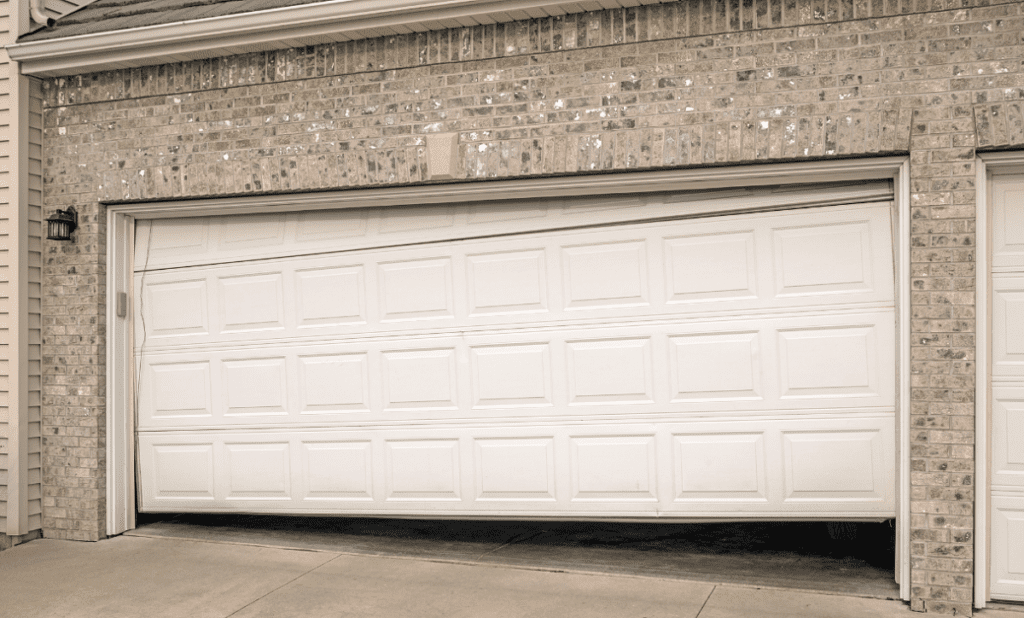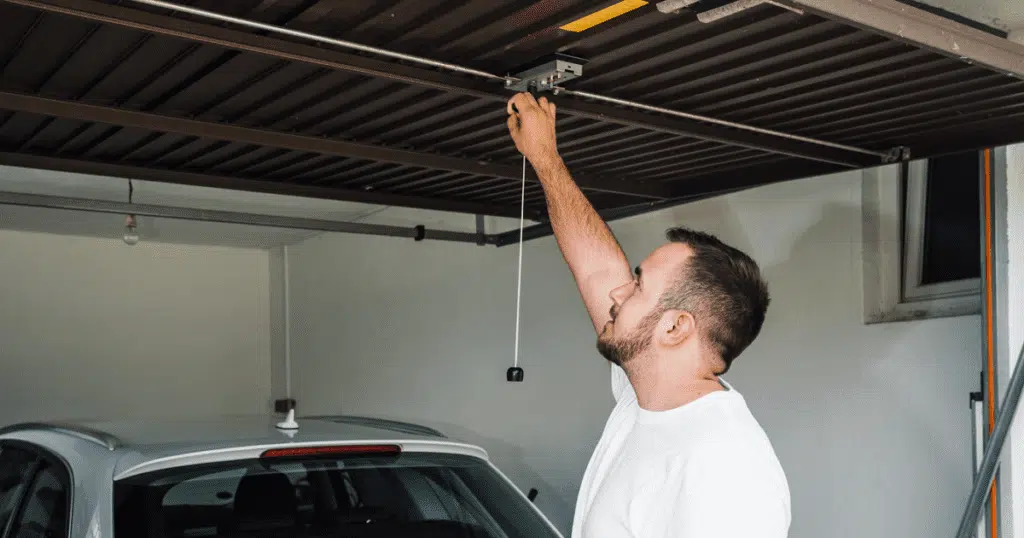
Why You Need to Fix This Problem
It happens every time it rains – you go out to your garage and see that irritating puddle of water on the floor right by the door. You try to jump over it, but inevitably, you end up stepping in it and tracking that dirty water into your house. Not only is it a major annoyance, but it is also a safety hazard. How to stop rain coming under the garage door?
You need to fix this problem before someone slips and falls and seriously hurts themselves. The garage is one of the most important parts of any home.
It’s where we park our cars, store our tools and equipment, and in some cases even use it as a workspace for hobbies or home businesses. The last thing you want is for rainwater or snowmelt to get inside your garage and ruin all your valuable possessions.
So why does this happen? There could be several reasons for water ingress under your garage door – an uneven floor damaged weatherstripping or improper installation of the door itself.
Whatever the cause may be, you need to find a solution as soon as possible before irreparable damage occurs. In this article, we will explore some common causes of water ingress under garage doors and offer practical solutions for fixing them permanently.
Common Causes of Rain Coming Under Garage Door
Uneven Garage Floor
One of the main reasons for rainwater to come under your garage door is due to an uneven garage floor. If the slope of your garage floor is towards the inside, then water will flow toward the inside of your garage. This can be due to a variety of reasons, including poor installation or settling over time.
When installing a new garage door, make sure that it is installed on a level surface. You can also use a flood barrier for garage doors or a garage door threshold to prevent water from flowing into your house through the gaps between your floor and the garage door.
Damaged Weatherstripping
Weatherstripping for garage doors helps in sealing off any gaps between the bottom of the door and the ground, preventing water from coming in. However, if it is damaged or worn out due to continuous usage and exposure to elements like rain and humidity, it will no longer serve its purpose well.
In such cases, you should replace it with a new one as soon as possible. You can choose from various options available in the market, like – the best weather seal for garage doors or garage door seal replacement, etc.
Improper Installation of the Garage Door
If installed improperly in the first place by not aligning tracks and rollers properly, you may face problems later with respect to water seepage inside your premises, along with other issues related to opening/closing, etc. Make sure that you install it correctly before using it. These are some common causes that lead to rainwater infiltration under your garage door, which ultimately leads to damages at a large scale over time.
Therefore, identify these issues early on and take necessary steps like DIY garage door weatherproofing or garage door drainage solutions, etc., so that you can have peace of mind during rainy seasons knowing that your garage is waterproof.
Quick Fixes for Temporary Relief
Placing Towels or Sandbags at the Base of the Door
Are you tired of seeing water seep into your garage every time it rains? Has it dawned on you that perhaps your garage door is not as efficient in keeping water out as it should be?
If so, then you need a quick solution to help remedy the problem. One solution is to place towels or sandbags at the base of the door.
While this temporary fix might seem like a good idea, I have to tell you that this approach will not keep water out permanently. Sure, it might keep your feet relatively dry for a short period, but eventually, water will find its way inside.
So why bother with such a fleeting solution when there are better long-term fixes available? Instead of using towels or sandbags, consider investing in some weatherstripping to seal gaps around your garage door.
Applying Duct Tape to Cover Gaps
Another quick fix that often comes up when discussing how to stop rain from coming under garage doors is applying duct tape over gaps. Now, I know duct tape has many uses and can work wonders in fixing various things around the house. However, preventing water ingress under garage doors isn’t one of them.
Duct tape may provide some temporary relief by preventing small amounts of rainwater from seeping in through cracks and crevices. But let’s face it: duct tape isn’t waterproof!
It will only take one heavy rainfall before realizing that using duct tape is useless in protecting your garage against flooding. Instead of wasting your time and resources applying duct tape over gaps on your garage door frame, invest in proper weather stripping and threshold seals that are made specifically for keeping water out.
DIY Garage Door Weatherproofing
When trying to prevent flooding from rainwater entering beneath an overhead garage door, one of the most common quick fixes homeowners use is DIY garage door weatherproofing. While that’s an excellent idea in theory, it’s essential to understand the limitations of DIY solutions. DIY weatherproofing options like rubber mats, door bottom water stoppers, or even using a garage door rain deflector can do more harm than good.
They might seem like a cheap and effective solution at first, but they can end up causing unexpected damage and often fail to provide the desired results. If you’re considering DIY garage door weatherproofing, I recommend proceeding with caution and only sticking to minor solutions such as applying a silicone-based caulk seal around your garage door frame or installing weatherstripping onto the bottom of your garage door for adequate insulation against water leaks.
Long-Term Solutions for Permanent Fix
Repairing Uneven Garage Floor
One of the major reasons why rainwater seeps through garage doors is an uneven garage floor. Identifying the low spots in the garage floor is the first step to fixing this problem. You can do so by inspecting your garage carefully, looking for any depressions or cracks that could allow water to enter.
The low spots must then be filled in with concrete or self-leveling compound to ensure that the floor is level. If you don’t fix this issue properly, it may lead to other problems, such as mold growth, foundation damage, and structural issues.
It might seem like a hassle, but getting your garage door waterproofed should be a priority if you want to avoid further headaches in the future. Investing a little bit of time and money now will save you from bigger headaches later.
Replacing Damaged Weatherstripping
Weatherstripping plays an essential role in keeping rainwater out of your garage during heavy rains. Over time, weatherstripping can become damaged due to wear and tear or exposure to harsh weather conditions.
Removing old weatherstripping is easy – just pull it out from its groove along with any nails or staples securing it in place. To install new weatherstripping, measure and cut it to fit the door frame.
Then slide it into place and secure it with nails or staples. A good quality weather seal for garage doors should be made from durable materials that can withstand extreme temperatures and harsh weather conditions such as snow, rain, wind, and heat waves.
Adjusting Garage Door Installation
Improper installation of a garage door can result in gaps between the door and frame, allowing water inside during heavy rains. Checking the alignment of tracks and rollers is important because misaligned tracks can cause additional wear on parts like springs leading to more costly repairs down the line.
Tightening loose bolts and screws is essential in making sure the door stays in place. Adjusting spring tension if necessary is also important because if they are too loose or too tight, it can cause the door to not open fully or close properly.
There are several ways to protect against rain getting under garage doors. Fixing uneven garage floors and replacing damaged weatherstripping with high-quality seals will make a big difference.
Also, adjusting garage door installation ensures that gaps between the frame and door are kept at a minimum. With these long-term solutions, you can rest easy knowing your garage is protected from heavy rains and flooding.
Preventive Maintenance Tips to Keep Water Out
Inspection and Cleaning of Gutters and Downspouts Around the Garage Area
Let me tell you something, folks. The problem with rainwater flooding your garage is not always because of a faulty garage door.
Sometimes, the culprit is poor drainage around your garage. So, if you want to keep water out of your precious haven for cars and tools, start by regularly inspecting and cleaning gutters and downspouts around the garage area.
Why is it so important? Well, listen up.
Clogged gutters and downspouts can lead to water overflow during heavy rains, causing water to pool in areas around your garage that are susceptible to seepage into the foundation or basement. This can lead to extensive damage in the long run.
So, don’t be lazy about cleaning out those gutters! Get up there with a pair of gloves and some elbow grease every few months (or more often if needed), and make sure water can flow freely away from your garage.
Cleaning Debris from Around Garage Door Tracks and Rollers
Now let’s talk about another easy step you can take to prevent rainwater from coming under your garage door: regular cleaning of debris around the tracks and rollers. You might be thinking, “But wait a minute! I’m not talking about rainwater seeping in through gaps in my door; I’m talking about water pooling outside my door!” Well, guess what?
If there’s enough debris clogging up the tracks or rollers on your garage door system, it can prevent proper sealing against rainwater too! So stop putting off that spring cleaning session in the garage already!
Grab a broom or shop vac and give those tracks and rollers a thorough sweep or vacuuming every few months (or more frequently if needed). You’ll be surprised at how much gunk can accumulate in those areas and how much of a difference it can make in keeping water out.
Sealing Any Gaps or Cracks in Walls Near the Garage Door
Alright, alright. I get it.
Some of you are dealing with garage doors that are beyond repair. Maybe they’re too old or damaged to be fixed by DIY garage door weatherproofing methods like installing a garage door threshold or flood barrier for your garage door.
Well, fear not! There’s still one more thing you can do to keep rainwater out of your precious garage: seal any gaps or cracks in walls near the garage door!
That’s right, folks. Even if your door itself is as good as new, water can still seep through cracks and gaps in the walls around it and pool up inside the garage.
So grab some caulk, weatherstripping, or any other sealing material that works best for your situation, and start sealing up those pesky gaps! If you’re not sure where to start, just search online for “garage door seal replacement” or “garage door weatherproofing” tips; there are plenty of resources out there to help you get started.
Folks: don’t let rainwater ruin your beloved garage! Take these simple preventive maintenance steps seriously and keep that water at bay!
Frequently Asked Questions
How do I stop the rain under my garage door?
To stop rain from coming under your garage door, consider installing a garage door threshold seal, which can effectively block water, dust, and pests. Make sure to choose a threshold seal of the right length and material for maximum effectiveness.
Why is rain coming in the bottom of my garage door?
Rain may be coming in the bottom of your garage door due to an old or worn-out seal or because the garage floor and door are not perfectly levels. You can fix this issue by replacing the seal or by installing a garage door threshold.
How do you stop water from coming under a door in heavy rain?
To prevent water from coming under a door during heavy rain, apply a high-quality door sweep to the bottom of the door. For added protection, consider using a flood barrier or sandbags outside the door during periods of heavy rainfall.
How do I stop water from coming into my garage door?
If water is coming into your garage door, start by checking the weather stripping at the bottom of the door – if it’s worn out or damaged, replace it promptly. Additionally, consider adding a water barrier or threshold at the base of the door to provide an extra layer of defense.
How do I stop water from coming under my garage wall?
To stop water from coming under your garage wall, you may need to install a French drain or another drainage system around the perimeter of your garage to redirect water away. If water seepage persists, it may be a good idea to consult with a waterproofing professional to determine the best course of action.






